

***Description for this plant available with future update!***


Yellow Flowering Magnolia (Magnolia x brooklynensis 'Yellow Bird') is a rare jewel in the landscape: a tree with giant canary yellow flowers! Yellow Bird is an upright, conical to pyramidal, large deciduous tree that can grow 40 feet tall in Kansas. This magnolia would be a fine residential specimen in sheltered locations with moist, rich soil with plenty of space to spread. Magnolias in general are a family of plants that have been around for millions of years and are among the most primitive of all flowers. In fact, most magnolia flowers evolved before bees and are thus pollinated by beetles. Magnolias generally grow in moist, well drained soils in sun or shade. They have no serious pests or disease problems.
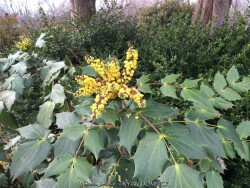

Leatherleaf Mahonia (Mahonia bealei) is a slow-growing coarse-textured evergreen shrub with bright green holly-like leaflets. The leaves are prickly and make a fine barrier or specimen plant. Native to continental climates in China, Mahonia bealei can be invasive in Eastern US woods where its shade tolerance and slow evergreen growth eventually shade out native plants. This is not a problem in Kansas due to extreme winters and dryer conditions. Flowering tries to occur in mid to late winter in Kansas but are usually frozen before they can open. During a "once in 5 years" mild winter if temperatures stay above 0 degrees F, fragrant, lemon-yellow flowers do develop. Even more rare is to have a long enough warm spell in winter to allow the beautiful blackish-blue fruit to develop afterward. If they do, they will be enjoyed by birds but any small seedlings that do germinate are killed by ground freezes the next winter. Leatherleaf Mahonia is very drought tolerant when established making it an ideal dry-shade plant; the 40 inches of typical rainfall in Eastern Kansas is sufficient if planted in rototilled soils. This could be one of the most cold-tolerant broadleaf evergreens available! It survived -16 degrees F and a week of single digit highs in February, 2021 with no damage. It even maintains bright green foliage in winter opposed to a dingy brownish-green like some evergreens. In Eastern Kansas, this species performs WELL with just about everything nature has to challenge it! Heat and drought are tolerated if in shade or morning sun. Cold tolerance is no problem. Invasiveness is not a problem. No disease or pest problems. And again, this is a great evergreen plant for difficult dry-shade situations under mature trees where lawn won't grow.
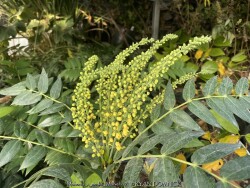

Leatherleaf Mahonia (Mahonia x media 'Marvel') is a slow-growing coarse-textured evergreen shrub with bright green holly-like leaflets. The leaves are prickly and make a fine barrier or specimen plant. Native to continental climates in China, Mahonia bealei can be invasive in Eastern US woods where its shade tolerance and slow evergreen growth eventually shade out native plants. This is not a problem in Kansas due to extreme winters and dryer conditions. Flowering tries to occur in mid to late winter in Kansas but are usually frozen before they can open. During a "once in 5 years" mild winter if temperatures stay above 0 degrees F, fragrant, lemon-yellow flowers do develop. Even more rare is to have a long enough warm spell in winter to allow the beautiful blackish-blue fruit to develop afterward. If they do, they will be enjoyed by birds but any small seedlings that do germinate are killed by ground freezes the next winter. Leatherleaf Mahonia is very drought tolerant when established making it an ideal dry-shade plant; the 40 inches of typical rainfall in Eastern Kansas is sufficient if planted in rototilled soils. This could be one of the more cold-tolerant broadleaf evergreens available! 'Marvel' survived -16 degrees F and a week of single digit highs in February, 2021 but with complete foliage loss. It even maintains bright green foliage in winter opposed to a dingy brownish-green like some evergreens. In Eastern Kansas, this species performs WELL with just about everything nature has to challenge it! Heat and drought are tolerated if in shade or morning sun. Cold tolerance is no problem. Invasiveness is not a problem. No disease or pest problems. And again, this is a great evergreen plant for difficult dry-shade situations under mature trees where lawn won't grow. Mahonia x media 'Marvel' is an improved cultivar that is more compact than other varieties. Evergreen foliage is a medium glossy green and more fine-textures compared to the species. Frond-like leaves develop in whorls and are arranged along coarsely branched stems creating an architectural effect. It is unknown at this point (2022) if flowers and fruit will develop here in Kansas zone 6a but it is doubtful seeing how it tries to bloom in the winter similar to the species.


***Description for this plant available with future update!*** Cacti are known for their spines, unusual shapes and beautiful flowers. Both succulents and cacti store water in their fleshy tissues. And can survive long periods without water. Cacti and succulents are usually grown as a deck/patio plant or house plant in Kansas. Grow in full sun with little to no extra watering except that which comes from rainfall. Generally, plants may be brought out in Late May through Early October in our zone 6a Lawrence, KS climate. To play is safe, potted plants are best moved in before autumn leaves begin to drop and before night temperatures get below 45 degrees F. It is very important to avoid the combination of wet and cold. Move to a bright interior window over the winter with little to no watering and keep above 50 degrees F. As a winter house plant, it will look presentable all winter long with little to no waterings. As a permanent house plant, provide bright light and allow the soil to dry completely between waterings and you will get many years of carefree enjoyment. Plants grown permanently indoors may eventually begin to elongate stretching for light and lose their spine color. It can be hard to reproduce the intense UV sunlight they need when growing indoors so moving outside for the summer is best. Generally if moving outside for the summer, allow 1-2 weeks of part shade or morning sun before placing in full sun. Plants with time to acclimate will thrive in full sun but be careful not to rush it or sunburning may occur. Repotting may or may not be needed depending on how large you want the plant to grow; plants can continue to grow taller and tolerate extremely root-bound pots but may need wind bracing. If repotting, make sure to use a sharp draining low organic cactus mix with plenty of sand and perlite but avoid peat moss. The “soil” most commercial cacti are potted in to too peaty and light weight. This soil becomes hydrophobic and shrinks after becoming bone dry and difficult to re wet again. Cacti never grow in peat-based soils in nature; this “Soil” is only good for shipping because of the light weight. Potted plants are very low maintenance but watch for scale and mealybugs that may hide beneath the cover of spines. The best pest removal approach is to periodically wash the cactus off. Achieve this with a water nozzle or hose breaker turned mostly off to increase the pressure from the blast of water. This high-pressured water kills the pests without damaging the thick cactus skin. Here are some little-known or rare factoids about cacti: 1. The "spines" are actually modified leaves filled with sap at first, then quickly drying out to form the spines! 2. Many cacti have bright colored flowers that mainly attract bees, while some tubular flowering types attract hummingbirds and bats. 3. Late on the evolutionary timeline, cacti fossils are rare to non-existent. Cacti are native almost exclusively to the Americas, while succulents can include a much larger plant palette be from any dry area in the world. 4. Some cactus plants have been known to survive more than 2 years without water. 5. Some cacti first evolved in a dry climate that later became wetter again. For example: several jungle species live as epiphytes in trees to achieve the fast drainage they need.


***Description for this plant available with future update!*** Cacti are known for their spines, unusual shapes and beautiful flowers. Both succulents and cacti store water in their fleshy tissues. And can survive long periods without water. Cacti and succulents are usually grown as a deck/patio plant or house plant in Kansas. Grow in full sun with little to no extra watering except that which comes from rainfall. Generally, plants may be brought out in Late May through Early October in our zone 6a Lawrence, KS climate. To play is safe, potted plants are best moved in before autumn leaves begin to drop and before night temperatures get below 45 degrees F. It is very important to avoid the combination of wet and cold. Move to a bright interior window over the winter with little to no watering and keep above 50 degrees F. As a winter house plant, it will look presentable all winter long with little to no waterings. As a permanent house plant, provide bright light and allow the soil to dry completely between waterings and you will get many years of carefree enjoyment. Plants grown permanently indoors may eventually begin to elongate stretching for light and lose their spine color. It can be hard to reproduce the intense UV sunlight they need when growing indoors so moving outside for the summer is best. Generally if moving outside for the summer, allow 1-2 weeks of part shade or morning sun before placing in full sun. Plants with time to acclimate will thrive in full sun but be careful not to rush it or sunburning may occur. Repotting may or may not be needed depending on how large you want the plant to grow; plants can continue to grow taller and tolerate extremely root-bound pots but may need wind bracing. If repotting, make sure to use a sharp draining low organic cactus mix with plenty of sand and perlite but avoid peat moss. The “soil” most commercial cacti are potted in to too peaty and light weight. This soil becomes hydrophobic and shrinks after becoming bone dry and difficult to re wet again. Cacti never grow in peat-based soils in nature; this “Soil” is only good for shipping because of the light weight. Potted plants are very low maintenance but watch for scale and mealybugs that may hide beneath the cover of spines. The best pest removal approach is to periodically wash the cactus off. Achieve this with a water nozzle or hose breaker turned mostly off to increase the pressure from the blast of water. This high-pressured water kills the pests without damaging the thick cactus skin. Here are some little-known or rare factoids about cacti: 1. The "spines" are actually modified leaves filled with sap at first, then quickly drying out to form the spines! 2. Many cacti have bright colored flowers that mainly attract bees, while some tubular flowering types attract hummingbirds and bats. 3. Late on the evolutionary timeline, cacti fossils are rare to non-existent. Cacti are native almost exclusively to the Americas, while succulents can include a much larger plant palette be from any dry area in the world. 4. Some cactus plants have been known to survive more than 2 years without water. 5. Some cacti first evolved in a dry climate that later became wetter again. For example: several jungle species live as epiphytes in trees to achieve the fast drainage they need.


***Description for this plant available with future update!*** Cacti are known for their spines, unusual shapes and beautiful flowers. Both succulents and cacti store water in their fleshy tissues. And can survive long periods without water. Cacti and succulents are usually grown as a deck/patio plant or house plant in Kansas. Grow in full sun with little to no extra watering except that which comes from rainfall. Generally, plants may be brought out in Late May through Early October in our zone 6a Lawrence, KS climate. To play is safe, potted plants are best moved in before autumn leaves begin to drop and before night temperatures get below 45 degrees F. It is very important to avoid the combination of wet and cold. Move to a bright interior window over the winter with little to no watering and keep above 50 degrees F. As a winter house plant, it will look presentable all winter long with little to no waterings. As a permanent house plant, provide bright light and allow the soil to dry completely between waterings and you will get many years of carefree enjoyment. Plants grown permanently indoors may eventually begin to elongate stretching for light and lose their spine color. It can be hard to reproduce the intense UV sunlight they need when growing indoors so moving outside for the summer is best. Generally if moving outside for the summer, allow 1-2 weeks of part shade or morning sun before placing in full sun. Plants with time to acclimate will thrive in full sun but be careful not to rush it or sunburning may occur. Repotting may or may not be needed depending on how large you want the plant to grow; plants can continue to grow taller and tolerate extremely root-bound pots but may need wind bracing. If repotting, make sure to use a sharp draining low organic cactus mix with plenty of sand and perlite but avoid peat moss. The “soil” most commercial cacti are potted in to too peaty and light weight. This soil becomes hydrophobic and shrinks after becoming bone dry and difficult to re wet again. Cacti never grow in peat-based soils in nature; this “Soil” is only good for shipping because of the light weight. Potted plants are very low maintenance but watch for scale and mealybugs that may hide beneath the cover of spines. The best pest removal approach is to periodically wash the cactus off. Achieve this with a water nozzle or hose breaker turned mostly off to increase the pressure from the blast of water. This high-pressured water kills the pests without damaging the thick cactus skin. Here are some little-known or rare factoids about cacti: 1. The "spines" are actually modified leaves filled with sap at first, then quickly drying out to form the spines! 2. Many cacti have bright colored flowers that mainly attract bees, while some tubular flowering types attract hummingbirds and bats. 3. Late on the evolutionary timeline, cacti fossils are rare to non-existent. Cacti are native almost exclusively to the Americas, while succulents can include a much larger plant palette be from any dry area in the world. 4. Some cactus plants have been known to survive more than 2 years without water. 5. Some cacti first evolved in a dry climate that later became wetter again. For example: several jungle species live as epiphytes in trees to achieve the fast drainage they need.


***Description for this plant available with future update!*** Cacti are known for their spines, unusual shapes and beautiful flowers. Both succulents and cacti store water in their fleshy tissues. And can survive long periods without water. Cacti and succulents are usually grown as a deck/patio plant or house plant in Kansas. Grow in full sun with little to no extra watering except that which comes from rainfall. Generally, plants may be brought out in Late May through Early October in our zone 6a Lawrence, KS climate. To play is safe, potted plants are best moved in before autumn leaves begin to drop and before night temperatures get below 45 degrees F. It is very important to avoid the combination of wet and cold. Move to a bright interior window over the winter with little to no watering and keep above 50 degrees F. As a winter house plant, it will look presentable all winter long with little to no waterings. As a permanent house plant, provide bright light and allow the soil to dry completely between waterings and you will get many years of carefree enjoyment. Plants grown permanently indoors may eventually begin to elongate stretching for light and lose their spine color. It can be hard to reproduce the intense UV sunlight they need when growing indoors so moving outside for the summer is best. Generally if moving outside for the summer, allow 1-2 weeks of part shade or morning sun before placing in full sun. Plants with time to acclimate will thrive in full sun but be careful not to rush it or sunburning may occur. Repotting may or may not be needed depending on how large you want the plant to grow; plants can continue to grow taller and tolerate extremely root-bound pots but may need wind bracing. If repotting, make sure to use a sharp draining low organic cactus mix with plenty of sand and perlite but avoid peat moss. The “soil” most commercial cacti are potted in to too peaty and light weight. This soil becomes hydrophobic and shrinks after becoming bone dry and difficult to re wet again. Cacti never grow in peat-based soils in nature; this “Soil” is only good for shipping because of the light weight. Potted plants are very low maintenance but watch for scale and mealybugs that may hide beneath the cover of spines. The best pest removal approach is to periodically wash the cactus off. Achieve this with a water nozzle or hose breaker turned mostly off to increase the pressure from the blast of water. This high-pressured water kills the pests without damaging the thick cactus skin. Here are some little-known or rare factoids about cacti: 1. The "spines" are actually modified leaves filled with sap at first, then quickly drying out to form the spines! 2. Many cacti have bright colored flowers that mainly attract bees, while some tubular flowering types attract hummingbirds and bats. 3. Late on the evolutionary timeline, cacti fossils are rare to non-existent. Cacti are native almost exclusively to the Americas, while succulents can include a much larger plant palette be from any dry area in the world. 4. Some cactus plants have been known to survive more than 2 years without water. 5. Some cacti first evolved in a dry climate that later became wetter again. For example: several jungle species live as epiphytes in trees to achieve the fast drainage they need.
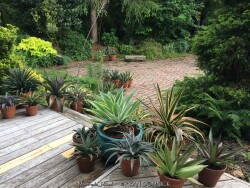

The variety of foliage colors and patterns make Mangave excellent architectural specimen plants. Mangave is a relatively new phenomenon, as a cross between the genus Manfreda and Agave. These rare hybrids combine the best of both worlds: the better growth rate and the interesting patterns of Manfreda, and the habit and refinement of Agave. Usually used as a patio or house plant in Kansas, they can also be grown as an annual. Grow in full sun to part sun with optional extra watering including that which comes from rainfall. Plants with time to acclimate will thrive in full sun but be careful not to rush it or sunburning will occur. Generally if moving outside for the summer, allow 2-3 weeks of part shade or morning sun before placing in full sun. Repotting may or may not be needed depending on how large you want the plant to grow; plants can continue to grow and tolerate extremely root-bound pots. Protect from temperatures below 35 degrees F and move into a bright window over the winter with no watering. Do not allow Mangave in pots to freeze solid or get close to freezing especially if soil is wet or death may occur. As a winter house plant, it will look presentable all winter long with just a few monthly or no waterings if you forget. As a permanent house plant, provide bright light and allow the soil to dry between waterings for many years of carefree enjoyment. Potted plants are very low maintenance needing only old leaves trimmed once per year. This is not at all a big-box store plant so be prepared to expand your plant palette with Mangave!


***Description for this plant available with future update!*** Cacti are known for their spines, unusual shapes and beautiful flowers. Both succulents and cacti store water in their fleshy tissues. And can survive long periods without water. Cacti and succulents are usually grown as a deck/patio plant or house plant in Kansas. Grow in full sun with little to no extra watering except that which comes from rainfall. Generally, plants may be brought out in Late May through Early October in our zone 6a Lawrence, KS climate. To play is safe, potted plants are best moved in before autumn leaves begin to drop and before night temperatures get below 45 degrees F. It is very important to avoid the combination of wet and cold. Move to a bright interior window over the winter with little to no watering and keep above 50 degrees F. As a winter house plant, it will look presentable all winter long with little to no waterings. As a permanent house plant, provide bright light and allow the soil to dry completely between waterings and you will get many years of carefree enjoyment. Plants grown permanently indoors may eventually begin to elongate stretching for light and lose their spine color. It can be hard to reproduce the intense UV sunlight they need when growing indoors so moving outside for the summer is best. Generally if moving outside for the summer, allow 1-2 weeks of part shade or morning sun before placing in full sun. Plants with time to acclimate will thrive in full sun but be careful not to rush it or sunburning may occur. Repotting may or may not be needed depending on how large you want the plant to grow; plants can continue to grow taller and tolerate extremely root-bound pots but may need wind bracing. If repotting, make sure to use a sharp draining low organic cactus mix with plenty of sand and perlite but avoid peat moss. The “soil” most commercial cacti are potted in to too peaty and light weight. This soil becomes hydrophobic and shrinks after becoming bone dry and difficult to re wet again. Cacti never grow in peat-based soils in nature; this “Soil” is only good for shipping because of the light weight. Potted plants are very low maintenance but watch for scale and mealybugs that may hide beneath the cover of spines. The best pest removal approach is to periodically wash the cactus off. Achieve this with a water nozzle or hose breaker turned mostly off to increase the pressure from the blast of water. This high-pressured water kills the pests without damaging the thick cactus skin. Here are some little-known or rare factoids about cacti: 1. The "spines" are actually modified leaves filled with sap at first, then quickly drying out to form the spines! 2. Many cacti have bright colored flowers that mainly attract bees, while some tubular flowering types attract hummingbirds and bats. 3. Late on the evolutionary timeline, cacti fossils are rare to non-existent. Cacti are native almost exclusively to the Americas, while succulents can include a much larger plant palette be from any dry area in the world. 4. Some cactus plants have been known to survive more than 2 years without water. 5. Some cacti first evolved in a dry climate that later became wetter again. For example: several jungle species live as epiphytes in trees to achieve the fast drainage they need.
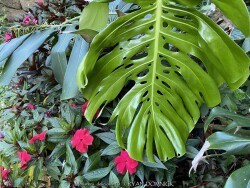

Split Leaf Philodendron / Swiss Cheese Plant (Monstera deliciosa) is a large tropical plant. This member of the arum family Araceae is an epiphyte with aerial roots, able to grow up to 66 ft high in the wild, with large, leathery, glossy, pinnate, heart-shaped leaves 12-36" ft long by 12-30" broad. The leaves on young plants are smaller and entire with no lobes or holes, but soon produce lobed and fenestrate leaves as they grow. Although it can grow very tall in nature, it only measures between 6-10 ft) when grown indoors. The older the plant, the more the leaves are covered with its familiar large perforations. This plant lives in the humid tropical forests, in the lowlands and middle mountains, in the extreme south of Mexico, Central America, and south tip of Florida. The seeds fall to the ground, then the seedlings grow towards the dark (negative phototropism) until they meet a tree on which to attach. The many adjacent roots thus allow the plant to anchor against its new support and reach the canopy light (although it rarely grows in full sun and prefers a light dimmed by the foliage). Monstera deliciosa is commonly grown outdoors as an ornamental plant in the tropics and subtropics. The plant requires a lot of space and a rich and loose soil (ideally garden soil and compost in equal parts). If it grows in the ground it is better to plant it near a tree, where it can climb, if not against a trellis. It is moderately greedy and needs to be watered just to keep the soil slightly moist. Hardy to zone 11, it cannot withstand freezing temperatures for more than a few hours. A steady minimum temperature of at least 55-59°F is preferable, allowing continuous growth. Growth ceases below 50°F but tolerant down to 32°F if kept on the dry side. Its architectural qualities, ease of cultivation, and tolerance of a wide range of conditions make it an ideal plant for indoor cultivation as well. For this reason it is a popular plant for the home or office throughout the temperate northern hemisphere. It prefers bright indirect light and temperatures of 68-86°F. Flowering is rare when grown indoors. Along with other tropicals and succulents in Kansas, Split Leaf Philodendron / Swiss Cheese Plant is usually grown as large summer patio plant. Water regularly and place in full shade or very limited morning sun possibly in a large ceramic pot under an established shade thee for the summer. They handle the transition moving in and out rather well and hold up nicely during winter if you have dark, cold, or un-ideal conditions provided that they get a good growing season outdoors for 1/2 the year.


***Shrub descriptions available with future update!***Morella cerifera, also known as Hardy Southern Wax Myrtle is a new evergreen addition to our Lawrence, KS zone 6 display garden. Very salt tolerant for areas near roads where salting is frequent in winter. ***Description for this plant available with future update!***
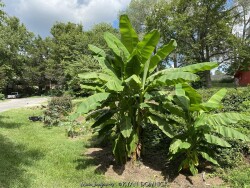

Create a tropical effect in your landscape with these large fast-growing cold hardy Musa basjoo! (also called Japanese fiber banana) Each leaf can be 6 feet long and 2 feet wide. Leave in ground and mulch 6" thick and they will return as perennials every year. If planting on the south side of a house in full sun, little protection is needed. These have proven hardy in Lawrence, KS (zone 6a) for over 20 years. In Eastern Kansas, typically our 40 inches of rainfall is sufficient without extra water in good soils. This species will tolerate some degree of drought but fastest growth will occur in rich well-drained soils with extra water and fertilizer provided during the summer. Great for summer wet areas in full sun or around swimming pools (creates no messes). Plants are capable of growing 15-18 feet by the end of summer when established and happy! A more realistic height is 7-12 feet under average conditions. Banana trees will slowly divide and send up offsets; this is a desirable sign that the banana tree is establishing well. If 1-2 feet of trunk is protected with a large pile of leaf mulch, you will get a flower followed by small inedible bananas the 2nd year on the largest trunk. The flowering trunk will die but the offsets will grow. Bananas will not tolerate excessively wet soils during dormancy. Sunburning can happen with summer temperatures over 100 degrees F but it will quickly outgrow the damage. Bananas need at least 1/2 day of full sun and protection from excessive winds to properly grow. Listed by many sources as hardy to zone 6 or 7, with proper mulching and placement near a foundation, you can easily grow this into zone 5 or possibly lower. In our trial gardens in Lawrence, KS (zone 6a), two well established specimens have thrived for 15 years and counting. During the arctic blast of February, 2021, lows down to -17 degrees F on Feb 16th, 2021 were recorded. The longevity of this cold blast was also impressive: 10 days on a row with highs of 10-15 degrees F or lower, 8 nights of lows in the single digits and negatives, and 36 straight hours of 0 degrees F and mostly lower. A hard ground freeze was inevitable; hundreds of plants around town survived this event returning a little late the following spring but otherwise just fine. Some were mulched with ground up leaf mulch, some were not.
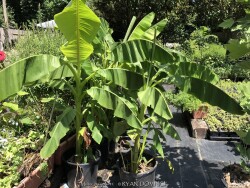

Create a tropical effect in your landscape with these large fast-growing cold hardy Musa basjoo! (also called Japanese fiber banana) Each leaf can be 6 feet long and 2 feet wide. Leave in ground and mulch 6" thick and they will return as perennials every year. If planting on the south side of a house in full sun, little protection is needed. These have proven hardy in Lawrence, KS (zone 6a) for over 20 years. In Eastern Kansas, typically our 40 inches of rainfall is sufficient without extra water in good soils. This species will tolerate some degree of drought but fastest growth will occur in rich well-drained soils with extra water and fertilizer provided during the summer. Great for summer wet areas in full sun or around swimming pools (creates no messes). Plants are capable of growing 15-18 feet by the end of summer when established and happy! A more realistic height is 7-12 feet under average conditions. Banana trees will slowly divide and send up offsets; this is a desirable sign that the banana tree is establishing well. If 1-2 feet of trunk is protected with a large pile of leaf mulch, you will get a flower followed by small inedible bananas the 2nd year on the largest trunk. The flowering trunk will die but the offsets will grow. Bananas will not tolerate excessively wet soils during dormancy. Sunburning can happen with summer temperatures over 100 degrees F but it will quickly outgrow the damage. Bananas need at least 1/2 day of full sun and protection from excessive winds to properly grow. Listed by many sources as hardy to zone 6 or 7, with proper mulching and placement near a foundation, you can easily grow this into zone 5 or possibly lower. In our trial gardens in Lawrence, KS (zone 6a), two well established specimens have thrived for 15 years and counting. During the arctic blast of February, 2021, lows down to -17 degrees F on Feb 16th, 2021 were recorded. The longevity of this cold blast was also impressive: 10 days on a row with highs of 10-15 degrees F or lower, 8 nights of lows in the single digits and negatives, and 36 straight hours of 0 degrees F and mostly lower. A hard ground freeze was inevitable; hundreds of plants around town survived this event returning a little late the following spring but otherwise just fine. Some were mulched with ground up leaf mulch, some were not.


Create a tropical effect in your landscape with these large fast-growing cold hardy Musa basjoo! (also called Japanese fiber banana) Each leaf can be 6 feet long and 2 feet wide. Leave in ground and mulch 6" thick and they will return as perennials every year. If planting on the south side of a house in full sun, little protection is needed. These have proven hardy in Lawrence, KS (zone 6a) for over 20 years. In Eastern Kansas, typically our 40 inches of rainfall is sufficient without extra water in good soils. This species will tolerate some degree of drought but fastest growth will occur in rich well-drained soils with extra water and fertilizer provided during the summer. Great for summer wet areas in full sun or around swimming pools (creates no messes). Plants are capable of growing 15-18 feet by the end of summer when established and happy! A more realistic height is 7-12 feet under average conditions. Banana trees will slowly divide and send up offsets; this is a desirable sign that the banana tree is establishing well. If 1-2 feet of trunk is protected with a large pile of leaf mulch, you will get a flower followed by small inedible bananas the 2nd year on the largest trunk. The flowering trunk will die but the offsets will grow. Bananas will not tolerate excessively wet soils during dormancy. Sunburning can happen with summer temperatures over 100 degrees F but it will quickly outgrow the damage. Bananas need at least 1/2 day of full sun and protection from excessive winds to properly grow. Listed by many sources as hardy to zone 6 or 7, with proper mulching and placement near a foundation, you can easily grow this into zone 5 or possibly lower. In our trial gardens in Lawrence, KS (zone 6a), two well established specimens have thrived for 15 years and counting. During the arctic blast of February, 2021, lows down to -17 degrees F on Feb 16th, 2021 were recorded. The longevity of this cold blast was also impressive: 10 days on a row with highs of 10-15 degrees F or lower, 8 nights of lows in the single digits and negatives, and 36 straight hours of 0 degrees F and mostly lower. A hard ground freeze was inevitable; hundreds of plants around town survived this event returning a little late the following spring but otherwise just fine. Some were mulched with ground up leaf mulch, some were not.


Create a tropical effect in your landscape with the worlds most cold red-leafed banana. Fast-growing and cold hardy, Red Hardy Banana Tree (Musa sikkimensis 'Ever Red') features reddish maroon striped randomly along the leaves in various widths to create a spectacular show! Leave in ground and mulch 6-9" thick and they will return as perennials every year. In Eastern Kansas, typically our 40 inches of rainfall is sufficient without extra water in good soils. This species will tolerate some degree of drought but fastest growth will occur in rich well-drained soils with extra water and fertilizer provided during the summer. Great for wet areas in full sun or around swimming pools (creates no messes). Plants are typically grow 5-8 feet by the end of summer and upto 15 feet in year two. Banana trees will slowly divide and send up offsets; this is a desirable sign that the banana tree is establishing well. The flowering trunk will die but many new offsets will take its place. Bananas will not tolerate excessively wet soils during dormancy. Sunburning can happen with summer temperatures over 100 degrees F but it will quickly outgrow the damage. Bananas need at least 1/2 day of full sun and protection from excessive winds to properly grow.
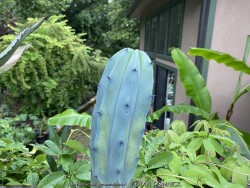

Blue Candle Cacti (Myrtillocactus geometrizans ) are known for its brilliant powder blue skin. If you touch it however, the powdery silver color permanently rubs off leaving a green skin underneath. Native to tropical deciduous forests in Mexico, it's usually grown as a patio or house plant in Kansas. In the wild, established blue candle cacti are hardy to 25 degrees F for short periods of time. Grow in full sun with occasional extra watering including that which comes from rainfall. Repotting may or may not be needed depending on how large you want the plant to grow; plants can continue to grow taller and tolerate extremely root-bound pots but may need wind bracing. If repotting, make sure to use a sharp draining medium organic cactus mix with plenty of sand and perlite. To play is safe, potted plants are best moved in before night temperatures get below 45 degrees F. It is important to avoid the combination of wet and cold. Before extreme cold occurs, move to a bright interior window over the winter with no watering and keep above freezing. As a winter house plant, it will look presentable all winter long with just no waterings. As a permanent house plant, provide bright light and allow the soil to dry between waterings for many years of carefree enjoyment. Plants grown permanently indoors may begin to elongate stretching for light and lose their spine color. It can be hard to reproduce the intense UV sunlight they need so moving outside for the summer is best. Generally if moving outside for the summer, allow 1-2 weeks of part shade or morning sun before placing in full sun. Plants with time to acclimate will thrive in full sun but be careful not to rush it or sunburning will occur. Potted plants are very low maintenance. I have never seen any insect problems on this plant.
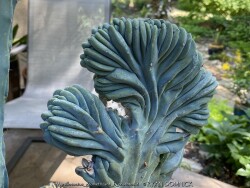

Dinosaur Back Cactus (Myrtillocactus geometrizans f. cristatus) are known for its brilliant powder blue skin on stems that crest and create waves as it grows. If you touch it however, the powdery silver color permanently rubs off leaving a green skin underneath. Native to tropical deciduous forests in Mexico, it's usually grown as a patio or house plant in Kansas. In the wild, established plants are hardy to 25 degrees F for short periods of time. Grow in full sun with occasional extra watering including that which comes from rainfall. Repotting may or may not be needed depending on how large you want the plant to grow; plants can continue to grow taller and tolerate extremely root-bound pots but may need wind bracing. If repotting, make sure to use a sharp draining medium organic cactus mix with plenty of sand and perlite. To play is safe, potted plants are best moved in before night temperatures get below 45 degrees F. It is important to avoid the combination of wet and cold. Before extreme cold occurs, move to a bright interior window over the winter with no watering and keep above freezing. As a winter house plant, it will look presentable all winter long with just no waterings. As a permanent house plant, provide bright light and allow the soil to dry between waterings for many years of carefree enjoyment. Plants grown permanently indoors may begin to elongate stretching for light and lose their spine color. It can be hard to reproduce the intense UV sunlight they need so moving outside for the summer is best. Generally if moving outside for the summer, allow 1-2 weeks of part shade or morning sun before placing in full sun. Plants with time to acclimate will thrive in full sun but be careful not to rush it or sunburning will occur. Potted plants are very low maintenance. I have never seen any insect problems on this plant. Dino is rare and will command a higher price than most other houseplants.
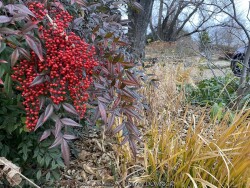

Nandina domestica is also called "Nandina" or "Heavenly Bamboo" despite not spreading or being related to bamboo at all. It is native to warm temperate climates in China. Bamboo-like foliage is very attractive with new growth emerging coppery peach with shades of pink and red in spring. During the summer, the foliage maintains a glossy deep to medium green color with no pest problems. White flowers appear which eventually turn into red fruits in the fall. Most birds do not like the fruit so they persist very well into winter down to about 0° F before freeze-drying to a reddish brown color and falling off. Often around Christmas time, the berries make a spectacular show combining classic colors of red and green in the winter landscape. The berries can be poisonous to some birds if they eat too many and all other food sources are depleted. This is a problem in your yard, please remove the fruits in the winter or before we have an arctic blast in which birds get desperate and will eat anything. The foliage is evergreen down to about -5° F and if colder, will simply become a deciduous shrub that year. If winter temperatures reach -10 or with strong winds, nandina will die to the ground like a perennial and come up from the base in April. In some parts of the country where winterkill never happens, nandina are invasive. (fruits spread by birds) This is likely in the Southeast and Texas south of zone 8b with plenty of rainfall. In those areas nandina will slowly take over the forest and displace native plants. There are many fruitless cultivars that can be used if invasiveness is a problem. In Kansas and in zone 5-7, This is never a problem because extreme winters keep the plant "in-check" and kill any seedlings trying to germinate. This shrub has a four-season appeal and is great for adding interest to Kansas landscapes in the winter. Best growth in Lawrence, KS (zone 6a) occurs when planted on South or West exposures benefiting from the hot micro climate. Nandina will also grow in just about any soil with full shade to full sun. If planted in full shade, growth will be very slow and extreme winters may kill them if not established; plant in spring only in this situation. Nandina look best in small to large groups. After established, its a "once it's there it's there forever" plant with very little maintenance. The only maintenance is cutting back winter kill occasionally or pruning to a more desirable mounded shape. It is worth noting that dwarf fruitless cultivars are less hardy in marginal zone 6 climates because of reduced ability to quickly recover from an occasional extreme winter.
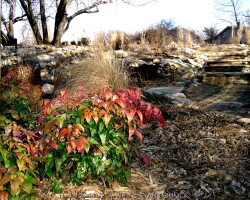

Nandina domestica is also called "Nandina" or "Heavenly Bamboo" despite not spreading or being related to bamboo at all. It is native to warm temperate climates in China. Bamboo-like foliage is very attractive with new growth emerging coppery peach with shades of pink and red in spring. During the summer, the foliage maintains a glossy deep to medium green color with no pest problems. White flowers appear which eventually turn into red fruits in the fall. Most birds do not like the fruit so they persist very well into winter down to about 0° F before freeze-drying to a reddish brown color and falling off. Often around Christmas time, the berries make a spectacular show combining classic colors of red and green in the winter landscape. The berries can be poisonous to some birds if they eat too many and all other food sources are depleted. This is a problem in your yard, please remove the fruits in the winter or before we have an arctic blast in which birds get desperate and will eat anything. The foliage is evergreen down to about -5° F and if colder, will simply become a deciduous shrub that year. If winter temperatures reach -10 or with strong winds, nandina will die to the ground like a perennial and come up from the base in April. In some parts of the country where winterkill never happens, nandina are invasive. (fruits spread by birds) This is likely in the Southeast and Texas south of zone 8b with plenty of rainfall. In those areas nandina will slowly take over the forest and displace native plants. There are many fruitless cultivars that can be used if invasiveness is a problem. In Kansas and in zone 5-7, This is never a problem because extreme winters keep the plant "in-check" and kill any seedlings trying to germinate. This shrub has a four-season appeal and is great for adding interest to Kansas landscapes in the winter. Best growth in Lawrence, KS (zone 6a) occurs when planted on South or West exposures benefiting from the hot micro climate. Nandina will also grow in just about any soil with full shade to full sun. If planted in full shade, growth will be very slow and extreme winters may kill them if not established; plant in spring only in this situation. Nandina look best in small to large groups. After established, its a "once it's there it's there forever" plant with very little maintenance. The only maintenance is cutting back winter kill occasionally or pruning to a more desirable mounded shape. It is worth noting that dwarf fruitless cultivars are less hardy in marginal zone 6 climates because of reduced ability to quickly recover from an occasional extreme winter. However, Nandina domestica 'Firepower' seems to persist well here!


Nandina domestica is also called "Nandina" or "Heavenly Bamboo" despite not spreading or being related to bamboo at all. It is native to warm temperate climates in China. Bamboo-like foliage is very attractive with new growth emerging coppery peach with shades of pink and red in spring. During the summer, the foliage maintains a glossy deep to medium green color with no pest problems. White flowers appear which eventually turn into red fruits in the fall. Most birds do not like the fruit so they persist very well into winter down to about 0° F before freeze-drying to a reddish brown color and falling off. Often around Christmas time, the berries make a spectacular show combining classic colors of red and green in the winter landscape. The berries can be poisonous to some birds if they eat too many and all other food sources are depleted. This is a problem in your yard, please remove the fruits in the winter or before we have an arctic blast in which birds get desperate and will eat anything. The foliage is evergreen down to about -5° F and if colder, will simply become a deciduous shrub that year. If winter temperatures reach -10 or with strong winds, nandina will die to the ground like a perennial and come up from the base in April. In some parts of the country where winterkill never happens, nandina are invasive. (fruits spread by birds) This is likely in the Southeast and Texas south of zone 8b with plenty of rainfall. In those areas nandina will slowly take over the forest and displace native plants. There are many fruitless cultivars that can be used if invasiveness is a problem. In Kansas and in zone 5-7, This is never a problem because extreme winters keep the plant "in-check" and kill any seedlings trying to germinate. This shrub has a four-season appeal and is great for adding interest to Kansas landscapes in the winter. Best growth in Lawrence, KS (zone 6a) occurs when planted on South or West exposures benefiting from the hot micro climate. Nandina will also grow in just about any soil with full shade to full sun. If planted in full shade, growth will be very slow and extreme winters may kill them if not established; plant in spring only in this situation. Nandina look best in small to large groups. After established, its a "once it's there it's there forever" plant with very little maintenance. The only maintenance is cutting back winter kill occasionally or pruning to a more desirable mounded shape. It is worth noting that dwarf fruitless cultivars are less hardy in marginal zone 6 climates because of reduced ability to quickly recover from an occasional extreme winter.
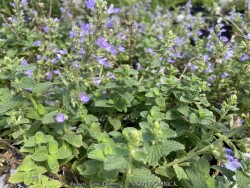

Nepeta (Catmint) Is one of the most adaptable, permanent perennials available in our climate and in your landscape! Definitely a "once it's their plant if there forever". Originally native to the Caucasus, Iran, Iraq, Turkey, there are numerous cultivars now with improved flowering and growth habit. Generally, the mint green foliage is fine textured and compact. Spring emergence in Kansas zone 6a is very early (usually in March) and will tolerate late freezes. This creates very early season interest in the garden while other plants are still dormant. Usually within a month of emerging, lavender-blue flowers cover the plant for up to six weeks. Pollinators enjoy the feast especially when catmint is used as a mass planting groundcover. Following spring flowering, many varieties develop attractive foliage and continual sporadic flowering. Some varieties have another big flower show in the fall especially if they are trimmed back and deadheaded once in late summer. Foliage is persistent and remains attractive late into the fall down to about 20° F providing late-season interest. Winter dried foliage is a somewhat attractive light gray and will eventually need to be cut or mowed to the ground before new growth emerges in the spring. Catmint is tolerant of almost any kind of soil including clay but will not tolerate poorly drained soil. Frequent watering is OK in normal garden soils but there is a risk of excessive growth and flopping. Catmint looks best in full sun but will still flower and look decent with part shade or 1/2 day full sun. This makes it adaptable to any side of the house even called northside if it gets full sun by mid-summer when the sun angle gets high. Cold hardiness or heat stress is not a problem at all in zone 6. Combine with just about any other perennial or shrub with a different flower and leaf color. It's hard to imagine a perennial or pollinator garden in Kansas without Catmint! Contrary to popular belief, cats do not destroy or eat this plant but may be attracted to it and create a nest beside it. They are really after catnip, a closely related plant. Nepeta 'Cat's Pajamas' is a long blooming perennial that's perfect in small areas of the landscape. Indigo blue flowers are produced all the way from the soil to the tips, providing an intense splash of color when it's in bloom. Rosy purple calyxes extend the color when the blooms are past peak. All Proven Winners® plants are legally propagated, healthy and vigorous, true to name, and tagged with color pictures and growing information.


Nepeta (Catmint) Is one of the most adaptable, permanent perennials available in our climate and in your landscape! Definitely a "once it's their plant if there forever". Originally native to the Caucasus, Iran, Iraq, Turkey, there are numerous cultivars now with improved flowering and growth habit. Generally, the mint green foliage is fine textured and compact. Spring emergence in Kansas zone 6a is very early (usually in March) and will tolerate late freezes. This creates very early season interest in the garden while other plants are still dormant. Usually within a month of emerging, lavender-blue flowers cover the plant for up to six weeks. Pollinators enjoy the feast especially when catmint is used as a mass planting groundcover. Following spring flowering, many varieties develop attractive foliage and continual sporadic flowering. Some varieties have another big flower show in the fall especially if they are trimmed back and deadheaded once in late summer. Foliage is persistent and remains attractive late into the fall down to about 20° F providing late-season interest. Winter dried foliage is a somewhat attractive light gray and will eventually need to be cut or mowed to the ground before new growth emerges in the spring. Catmint is tolerant of almost any kind of soil including clay but will not tolerate poorly drained soil. Frequent watering is OK in normal garden soils but there is a risk of excessive growth and flopping. Catmint looks best in full sun but will still flower and look decent with part shade or 1/2 day full sun. This makes it adaptable to any side of the house even called northside if it gets full sun by mid-summer when the sun angle gets high. Cold hardiness or heat stress is not a problem at all in zone 6. Combine with just about any other perennial or shrub with a different flower and leaf color. It's hard to imagine a perennial or pollinator garden in Kansas without Catmint! Contrary to popular belief, cats do not destroy or eat this plant but may be attracted to it and create a nest beside it. They are really after catnip, a closely related plant. Nepeta 'Cat's Pajamas' is a long blooming perennial that's perfect in small areas of the landscape. Indigo blue flowers are produced all the way from the soil to the tips, providing an intense splash of color when it's in bloom. Rosy purple calyxes extend the color when the blooms are past peak. All Proven Winners® plants are legally propagated, healthy and vigorous, true to name, and tagged with color pictures and growing information.
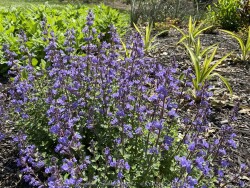

Nepeta (Catmint) Is one of the most adaptable, permanent perennials available in our climate and in your landscape! Definitely a "once it's their plant if there forever". Originally native to the Caucasus, Iran, Iraq, Turkey, there are numerous cultivars now with improved flowering and growth habit. Generally, the mint green foliage is fine textured and compact. Spring emergence in Kansas zone 6a is very early (usually in March) and will tolerate late freezes. This creates very early season interest in the garden while other plants are still dormant. Usually within a month of emerging, lavender-blue flowers cover the plant for up to six weeks. Pollinators enjoy the feast especially when catmint is used as a mass planting groundcover. Following spring flowering, many varieties develop attractive foliage and continual sporadic flowering. Some varieties have another big flower show in the fall especially if they are trimmed back and deadheaded once in late summer. Foliage is persistent and remains attractive late into the fall down to about 20° F providing late-season interest. Winter dried foliage is a somewhat attractive light gray and will eventually need to be cut or mowed to the ground before new growth emerges in the spring. Catmint is tolerant of almost any kind of soil including clay but will not tolerate poorly drained soil. Frequent watering is OK in normal garden soils but there is a risk of excessive growth and flopping. Catmint looks best in full sun but will still flower and look decent with part shade or 1/2 day full sun. This makes it adaptable to any side of the house even called northside if it gets full sun by mid-summer when the sun angle gets high. Cold hardiness or heat stress is not a problem at all in zone 6. Combine with just about any other perennial or shrub with a different flower and leaf color. It's hard to imagine a perennial or pollinator garden in Kansas without Catmint! Contrary to popular belief, cats do not destroy or eat this plant but may be attracted to it and create a nest beside it. They are really after catnip, a closely related plant. Nepeta grandiflora 'Summer Magic' is a free-blooming catmint that lives up to its namesake‚¬€it is summer magic! It blooms all season long on upright stems that never flop, even in the worst of storms. It stays fresh looking even in the heat and humidity of summer as other nepeta varieties tend to fade.
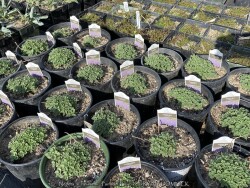

Nepeta (Catmint) Is one of the most adaptable, permanent perennials available in our climate and in your landscape! Definitely a "once it's their plant if there forever". Originally native to the Caucasus, Iran, Iraq, Turkey, there are numerous cultivars now with improved flowering and growth habit. Generally, the mint green foliage is fine textured and compact. Spring emergence in Kansas zone 6a is very early (usually in March) and will tolerate late freezes. This creates very early season interest in the garden while other plants are still dormant. Usually within a month of emerging, lavender-blue flowers cover the plant for up to six weeks. Pollinators enjoy the feast especially when catmint is used as a mass planting groundcover. Following spring flowering, many varieties develop attractive foliage and continual sporadic flowering. Some varieties have another big flower show in the fall especially if they are trimmed back and deadheaded once in late summer. Foliage is persistent and remains attractive late into the fall down to about 20° F providing late-season interest. Winter dried foliage is a somewhat attractive light gray and will eventually need to be cut or mowed to the ground before new growth emerges in the spring. Catmint is tolerant of almost any kind of soil including clay but will not tolerate poorly drained soil. Frequent watering is OK in normal garden soils but there is a risk of excessive growth and flopping. Catmint looks best in full sun but will still flower and look decent with part shade or 1/2 day full sun. This makes it adaptable to any side of the house even called northside if it gets full sun by mid-summer when the sun angle gets high. Cold hardiness or heat stress is not a problem at all in zone 6. Combine with just about any other perennial or shrub with a different flower and leaf color. It's hard to imagine a perennial or pollinator garden in Kansas without Catmint! Contrary to popular belief, cats do not destroy or eat this plant but may be attracted to it and create a nest beside it. They are really after catnip, a closely related plant.
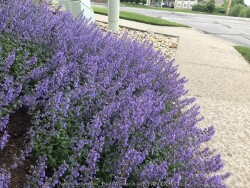

Nepeta (Catmint) Is one of the most adaptable, permanent perennials available in our climate and in your landscape! Definitely a "once it's their plant if there forever". Originally native to the Caucasus, Iran, Iraq, Turkey, there are numerous cultivars now with improved flowering and growth habit. Generally, the mint green foliage is fine textured and compact. Spring emergence in Kansas zone 6a is very early (usually in March) and will tolerate late freezes. This creates very early season interest in the garden while other plants are still dormant. Usually within a month of emerging, lavender-blue flowers cover the plant for up to six weeks. Pollinators enjoy the feast especially when catmint is used as a mass planting groundcover. Following spring flowering, many varieties develop attractive foliage and continual sporadic flowering. Some varieties have another big flower show in the fall especially if they are trimmed back and deadheaded once in late summer. Foliage is persistent and remains attractive late into the fall down to about 20° F providing late-season interest. Winter dried foliage is a somewhat attractive light gray and will eventually need to be cut or mowed to the ground before new growth emerges in the spring. Catmint is tolerant of almost any kind of soil including clay but will not tolerate poorly drained soil. Frequent watering is OK in normal garden soils but there is a risk of excessive growth and flopping. Catmint looks best in full sun but will still flower and look decent with part shade or 1/2 day full sun. This makes it adaptable to any side of the house even called northside if it gets full sun by mid-summer when the sun angle gets high. Cold hardiness or heat stress is not a problem at all in zone 6. Combine with just about any other perennial or shrub with a different flower and leaf color. It's hard to imagine a perennial or pollinator garden in Kansas without Catmint! Contrary to popular belief, cats do not destroy or eat this plant but may be attracted to it and create a nest beside it. They are really after catnip, a closely related plant. Nepeta x faassenii 'Blue Wonder' flowers that are a shade closer to blue. It will form low mounds of slightly greener leaves than most catmint. It may self-seed in optimum growing conditions in Kansas.
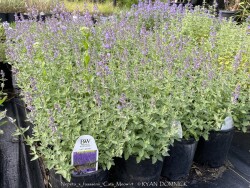

Nepeta (Catmint) Is one of the most adaptable, permanent perennials available in our climate and in your landscape! Definitely a "once it's their plant if there forever". Originally native to the Caucasus, Iran, Iraq, Turkey, there are numerous cultivars now with improved flowering and growth habit. Generally, the mint green foliage is fine textured and compact. Spring emergence in Kansas zone 6a is very early (usually in March) and will tolerate late freezes. This creates very early season interest in the garden while other plants are still dormant. Usually within a month of emerging, lavender-blue flowers cover the plant for up to six weeks. Pollinators enjoy the feast especially when catmint is used as a mass planting groundcover. Following spring flowering, many varieties develop attractive foliage and continual sporadic flowering. Some varieties have another big flower show in the fall especially if they are trimmed back and deadheaded once in late summer. Foliage is persistent and remains attractive late into the fall down to about 20° F providing late-season interest. Winter dried foliage is a somewhat attractive light gray and will eventually need to be cut or mowed to the ground before new growth emerges in the spring. Catmint is tolerant of almost any kind of soil including clay but will not tolerate poorly drained soil. Frequent watering is OK in normal garden soils but there is a risk of excessive growth and flopping. Catmint looks best in full sun but will still flower and look decent with part shade or 1/2 day full sun. This makes it adaptable to any side of the house even called northside if it gets full sun by mid-summer when the sun angle gets high. Cold hardiness or heat stress is not a problem at all in zone 6. Combine with just about any other perennial or shrub with a different flower and leaf color. It's hard to imagine a perennial or pollinator garden in Kansas without Catmint! Contrary to popular belief, cats do not destroy or eat this plant but may be attracted to it and create a nest beside it. They are really after catnip, a closely related plant. Nepeta x faassenii 'Cats Meow' in a new variety from Proven Winners® No catmint is a more beautiful, uniform grower than 'Cat's Meow' Nepeta. Its flowers are dense and colorful, and its habit is more refined. Plus, it stands strong with no flopping, getting wider and growing to a broad mound as the season progresses. All Proven Winners® plants are legally propagated, healthy and vigorous, true to name, and tagged with color pictures and growing information.
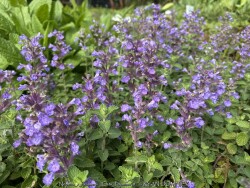

Nepeta (Catmint) Is one of the most adaptable, permanent perennials available in our climate and in your landscape! Definitely a "once it's their plant if there forever". Originally native to the Caucasus, Iran, Iraq, Turkey, there are numerous cultivars now with improved flowering and growth habit. Generally, the mint green foliage is fine textured and compact. Spring emergence in Kansas zone 6a is very early (usually in March) and will tolerate late freezes. This creates very early season interest in the garden while other plants are still dormant. Usually within a month of emerging, lavender-blue flowers cover the plant for up to six weeks. Pollinators enjoy the feast especially when catmint is used as a mass planting groundcover. Following spring flowering, many varieties develop attractive foliage and continual sporadic flowering. Some varieties have another big flower show in the fall especially if they are trimmed back and deadheaded once in late summer. Foliage is persistent and remains attractive late into the fall down to about 20° F providing late-season interest. Winter dried foliage is a somewhat attractive light gray and will eventually need to be cut or mowed to the ground before new growth emerges in the spring. Catmint is tolerant of almost any kind of soil including clay but will not tolerate poorly drained soil. Frequent watering is OK in normal garden soils but there is a risk of excessive growth and flopping. Catmint looks best in full sun but will still flower and look decent with part shade or 1/2 day full sun. This makes it adaptable to any side of the house even called northside if it gets full sun by mid-summer when the sun angle gets high. Cold hardiness or heat stress is not a problem at all in zone 6. Combine with just about any other perennial or shrub with a different flower and leaf color. It's hard to imagine a perennial or pollinator garden in Kansas without Catmint! Contrary to popular belief, cats do not destroy or eat this plant but may be attracted to it and create a nest beside it. They are really after catnip, a closely related plant. Nepeta x faassenii 'Cats Pajamas' in a new variety from Proven Winners® Unlike older varieties that only produce flowers at the top of the stems, this improved Catmint has blooms from the soil to the tips of the stems. Even when the flowers are past peak, the color of the rosy purple calyxes give your garden an additional splash of color. Compared to "Cats Meow", its flowers are the same but overall plant height is about 1/2-2/3rds. Plus, it stands strong with no flopping, getting wider and growing to a broad mound as the season progresses. All Proven Winners® plants are legally propagated, healthy and vigorous, true to name, and tagged with color pictures and growing information. PERENNIAL OF THE YEAR in 2021!
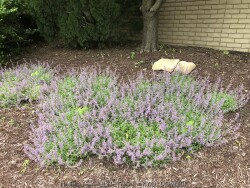

Nepeta (Catmint) Is one of the most adaptable, permanent perennials available in our climate and in your landscape! Definitely a "once it's their plant if there forever". Originally native to the Caucasus, Iran, Iraq, Turkey, there are numerous cultivars now with improved flowering and growth habit. Generally, the mint green foliage is fine textured and compact. Spring emergence in Kansas zone 6a is very early (usually in March) and will tolerate late freezes. This creates very early season interest in the garden while other plants are still dormant. Usually within a month of emerging, lavender-blue flowers cover the plant for up to six weeks. Pollinators enjoy the feast especially when catmint is used as a mass planting groundcover. Following spring flowering, many varieties develop attractive foliage and continual sporadic flowering. Some varieties have another big flower show in the fall especially if they are trimmed back and deadheaded once in late summer. Foliage is persistent and remains attractive late into the fall down to about 20° F providing late-season interest. Winter dried foliage is a somewhat attractive light gray and will eventually need to be cut or mowed to the ground before new growth emerges in the spring. Catmint is tolerant of almost any kind of soil including clay but will not tolerate poorly drained soil. Frequent watering is OK in normal garden soils but there is a risk of excessive growth and flopping. Catmint looks best in full sun but will still flower and look decent with part shade or 1/2 day full sun. This makes it adaptable to any side of the house even called northside if it gets full sun by mid-summer when the sun angle gets high. Cold hardiness or heat stress is not a problem at all in zone 6. Combine with just about any other perennial or shrub with a different flower and leaf color. It's hard to imagine a perennial or pollinator garden in Kansas without Catmint! Contrary to popular belief, cats do not destroy or eat this plant but may be attracted to it and create a nest beside it. They are really after catnip, a closely related plant. Nepeta x faassenii 'Little Trudy' is a compact, long-blooming catmint only 8-10" tall.
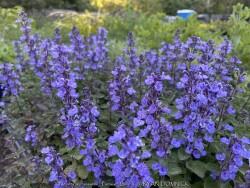

Nepeta (Catmint) Is one of the most adaptable, permanent perennials available in our climate and in your landscape! Definitely a "once it's their plant if there forever". Originally native to the Caucasus, Iran, Iraq, Turkey, there are numerous cultivars now with improved flowering and growth habit. Generally, the mint green foliage is fine textured and compact. Spring emergence in Kansas zone 6a is very early (usually in March) and will tolerate late freezes. This creates very early season interest in the garden while other plants are still dormant. Usually within a month of emerging, lavender-blue flowers cover the plant for up to six weeks. Pollinators enjoy the feast especially when catmint is used as a mass planting groundcover. Following spring flowering, many varieties develop attractive foliage and continual sporadic flowering. Some varieties have another big flower show in the fall especially if they are trimmed back and deadheaded once in late summer. Foliage is persistent and remains attractive late into the fall down to about 20° F providing late-season interest. Winter dried foliage is a somewhat attractive light gray and will eventually need to be cut or mowed to the ground before new growth emerges in the spring. Catmint is tolerant of almost any kind of soil including clay but will not tolerate poorly drained soil. Frequent watering is OK in normal garden soils but there is a risk of excessive growth and flopping. Catmint looks best in full sun but will still flower and look decent with part shade or 1/2 day full sun. This makes it adaptable to any side of the house even called northside if it gets full sun by mid-summer when the sun angle gets high. Cold hardiness or heat stress is not a problem at all in zone 6. Combine with just about any other perennial or shrub with a different flower and leaf color. It's hard to imagine a perennial or pollinator garden in Kansas without Catmint! Contrary to popular belief, cats do not destroy or eat this plant but may be attracted to it and create a nest beside it. They are really after catnip, a closely related plant. Nepeta faassenii 'Purrsian Blue' was introduced by Walter's Garden, Inc. This selection has an improved tidy habit, though it is a bit smaller and more compact in size overall than others. This is a very floriferous selection whose flower power is amplified by its having its flowers spaced closely together on the stems. Periwinkle blue flowers are coddled by dark purple calyxes just above the aromatic foliage from early summer into early fall.
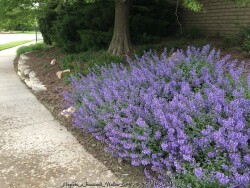

Nepeta (Catmint) Is one of the most adaptable, permanent perennials available in our climate and in your landscape! Definitely a "once it's their plant if there forever". Originally native to the Caucasus, Iran, Iraq, Turkey, there are numerous cultivars now with improved flowering and growth habit. Generally, the mint green foliage is fine textured and compact. Spring emergence in Kansas zone 6a is very early (usually in March) and will tolerate late freezes. This creates very early season interest in the garden while other plants are still dormant. Usually within a month of emerging, lavender-blue flowers cover the plant for up to six weeks. Pollinators enjoy the feast especially when catmint is used as a mass planting groundcover. Following spring flowering, many varieties develop attractive foliage and continual sporadic flowering. Some varieties have another big flower show in the fall especially if they are trimmed back and deadheaded once in late summer. Foliage is persistent and remains attractive late into the fall down to about 20° F providing late-season interest. Winter dried foliage is a somewhat attractive light gray and will eventually need to be cut or mowed to the ground before new growth emerges in the spring. Catmint is tolerant of almost any kind of soil including clay but will not tolerate poorly drained soil. Frequent watering is OK in normal garden soils but there is a risk of excessive growth and flopping. Catmint looks best in full sun but will still flower and look decent with part shade or 1/2 day full sun. This makes it adaptable to any side of the house even called northside if it gets full sun by mid-summer when the sun angle gets high. Cold hardiness or heat stress is not a problem at all in zone 6. Combine with just about any other perennial or shrub with a different flower and leaf color. It's hard to imagine a perennial or pollinator garden in Kansas without Catmint! Contrary to popular belief, cats do not destroy or eat this plant but may be attracted to it and create a nest beside it. They are really after catnip, a closely related plant. Nepeta x faassenii 'Walker Jr' is a compact, long-blooming catmint only 12-16" tall.
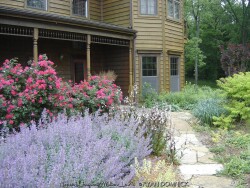

Nepeta (Catmint) Is one of the most adaptable, permanent perennials available in our climate and in your landscape! Definitely a "once it's their plant if there forever". Originally native to the Caucasus, Iran, Iraq, Turkey, there are numerous cultivars now with improved flowering and growth habit. Generally, the mint green foliage is fine textured and compact. Spring emergence in Kansas zone 6a is very early (usually in March) and will tolerate late freezes. This creates very early season interest in the garden while other plants are still dormant. Usually within a month of emerging, lavender-blue flowers cover the plant for up to six weeks. Pollinators enjoy the feast especially when catmint is used as a mass planting groundcover. Following spring flowering, many varieties develop attractive foliage and continual sporadic flowering. Some varieties have another big flower show in the fall especially if they are trimmed back and deadheaded once in late summer. Foliage is persistent and remains attractive late into the fall down to about 20° F providing late-season interest. Winter dried foliage is a somewhat attractive light gray and will eventually need to be cut or mowed to the ground before new growth emerges in the spring. Catmint is tolerant of almost any kind of soil including clay but will not tolerate poorly drained soil. Frequent watering is OK in normal garden soils but there is a risk of excessive growth and flopping. Catmint looks best in full sun but will still flower and look decent with part shade or 1/2 day full sun. This makes it adaptable to any side of the house even called northside if it gets full sun by mid-summer when the sun angle gets high. Cold hardiness or heat stress is not a problem at all in zone 6. Combine with just about any other perennial or shrub with a different flower and leaf color. It's hard to imagine a perennial or pollinator garden in Kansas without Catmint! Contrary to popular belief, cats do not destroy or eat this plant but may be attracted to it and create a nest beside it. They are really after catnip, a closely related plant. Nepeta x faassenii 'Walker's Low' is contradictorily a "tall" mounding plant grows to 2 to 3 feet tall and wide. If you want a very robust death-proof catmint, this is the one. I have also seen this plant effectively covering large sloped areas along roads with no bare spots or dead plants. Excellent when cascading off walls or container edges.


Nepeta (Catmint) Is one of the most adaptable, permanent perennials available in our climate and in your landscape! Definitely a "once it's their plant if there forever". Originally native to the Caucasus, Iran, Iraq, Turkey, there are numerous cultivars now with improved flowering and growth habit. Generally, the mint green foliage is fine textured and compact. Spring emergence in Kansas zone 6a is very early (usually in March) and will tolerate late freezes. This creates very early season interest in the garden while other plants are still dormant. Usually within a month of emerging, lavender-blue flowers cover the plant for up to six weeks. Pollinators enjoy the feast especially when catmint is used as a mass planting groundcover. Following spring flowering, many varieties develop attractive foliage and continual sporadic flowering. Some varieties have another big flower show in the fall especially if they are trimmed back and deadheaded once in late summer. Foliage is persistent and remains attractive late into the fall down to about 20° F providing late-season interest. Winter dried foliage is a somewhat attractive light gray and will eventually need to be cut or mowed to the ground before new growth emerges in the spring. Catmint is tolerant of almost any kind of soil including clay but will not tolerate poorly drained soil. Frequent watering is OK in normal garden soils but there is a risk of excessive growth and flopping. Catmint looks best in full sun but will still flower and look decent with part shade or 1/2 day full sun. This makes it adaptable to any side of the house even called northside if it gets full sun by mid-summer when the sun angle gets high. Cold hardiness or heat stress is not a problem at all in zone 6. Combine with just about any other perennial or shrub with a different flower and leaf color. It's hard to imagine a perennial or pollinator garden in Kansas without Catmint! Contrary to popular belief, cats do not destroy or eat this plant but may be attracted to it and create a nest beside it. They are really after catnip, a closely related plant.
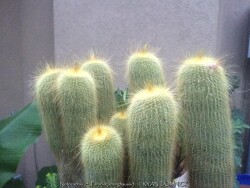

Golden Ball Cacti (Notocactus / Parodia leninghausii) are known for their bright yellow "soft" spines. Native to rocky hills and grasslands in high country Brazil, it's usually grown as a patio or house plant in Kansas. In the wild, established golden ball cacti are hardy to 30 degrees F for short periods of time. Grow in full sun with no extra watering except that which comes from rainfall. Repotting may or may not be needed depending on how large you want the plant to grow; plants can continue to grow taller and tolerate extremely root-bound pots but may need wind bracing. If repotting, make sure to use a sharp draining medium organic cactus mix with plenty of sand and perlite. To play is safe, potted plants are best moved in before night temperatures get below 45 degrees F. It is important to avoid the combination of wet and cold. Before extreme cold occurs, move to a bright interior window over the winter with no watering and keep above freezing. As a winter house plant, it will look presentable all winter long with just no waterings. As a permanent house plant, provide bright light and allow the soil to dry between waterings for many years of carefree enjoyment. Plants grown permanently indoors may begin to elongate stretching for light and lose their spine color. It can be hard to reproduce the intense UV sunlight they need so moving outside for the summer is best. Generally if moving outside for the summer, allow 1-2 weeks of part shade or morning sun before placing in full sun. Plants with time to acclimate will thrive in full sun but be careful not to rush it or sunburning will occur. Potted plants are very low maintenance. I have never seen any insect problems on this plant.


***Description for this plant available with future update!*** Cacti are known for their spines, unusual shapes and beautiful flowers. Both succulents and cacti store water in their fleshy tissues. And can survive long periods without water. Cacti and succulents are usually grown as a deck/patio plant or house plant in Kansas. Grow in full sun with little to no extra watering except that which comes from rainfall. Generally, plants may be brought out in Late May through Early October in our zone 6a Lawrence, KS climate. To play is safe, potted plants are best moved in before autumn leaves begin to drop and before night temperatures get below 45 degrees F. It is very important to avoid the combination of wet and cold. Move to a bright interior window over the winter with little to no watering and keep above 50 degrees F. As a winter house plant, it will look presentable all winter long with little to no waterings. As a permanent house plant, provide bright light and allow the soil to dry completely between waterings and you will get many years of carefree enjoyment. Plants grown permanently indoors may eventually begin to elongate stretching for light and lose their spine color. It can be hard to reproduce the intense UV sunlight they need when growing indoors so moving outside for the summer is best. Generally if moving outside for the summer, allow 1-2 weeks of part shade or morning sun before placing in full sun. Plants with time to acclimate will thrive in full sun but be careful not to rush it or sunburning may occur. Repotting may or may not be needed depending on how large you want the plant to grow; plants can continue to grow taller and tolerate extremely root-bound pots but may need wind bracing. If repotting, make sure to use a sharp draining low organic cactus mix with plenty of sand and perlite but avoid peat moss. The “soil” most commercial cacti are potted in to too peaty and light weight. This soil becomes hydrophobic and shrinks after becoming bone dry and difficult to re wet again. Cacti never grow in peat-based soils in nature; this “Soil” is only good for shipping because of the light weight. Potted plants are very low maintenance but watch for scale and mealybugs that may hide beneath the cover of spines. The best pest removal approach is to periodically wash the cactus off. Achieve this with a water nozzle or hose breaker turned mostly off to increase the pressure from the blast of water. This high-pressured water kills the pests without damaging the thick cactus skin. Here are some little-known or rare factoids about cacti: 1. The "spines" are actually modified leaves filled with sap at first, then quickly drying out to form the spines! 2. Many cacti have bright colored flowers that mainly attract bees, while some tubular flowering types attract hummingbirds and bats. 3. Late on the evolutionary timeline, cacti fossils are rare to non-existent. Cacti are native almost exclusively to the Americas, while succulents can include a much larger plant palette be from any dry area in the world. 4. Some cactus plants have been known to survive more than 2 years without water. 5. Some cacti first evolved in a dry climate that later became wetter again. For example: several jungle species live as epiphytes in trees to achieve the fast drainage they need.
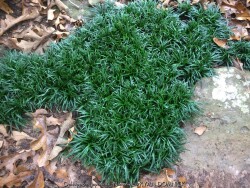

***Description for this perennial available with future update!***Dwarf Mondo Grass, is also known as Ophiopogon japonicus 'Nana'
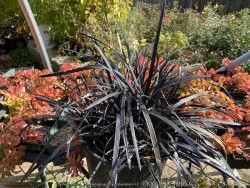

***Description for this perennial available with future update!***Black Mondo Grass, is also known as Ophiopogon planiscapus 'Arabicus'


***Description for this plant available with future update!*** With extremely well drained soils and proper siting, this cactus seems to take our excess rainfall in Eastern Kansas. These and other hardy barrel cacti are perfect for a dry mounded xeriscape gardens under south facing roof overhangs where it gets no winter moisture. We are also testing this outside in our Lawrence, KS (zone 6a) crevice garden among other cold-hardy cacti, succulents, and yucca! Watch for future updates-Jan-2025
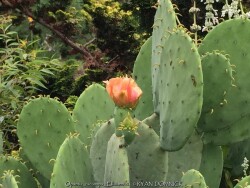

This prickly pear (Opuntia cacanapa 'Ellisiana') is truly spineless! Yes, completely spineless and free of glochids. The smooth green paddles and upright growth habit create a unique addition to the desert garden. The pads are sparsely spined, light green, and hardy to about 0 degrees F. This cactus has a place as one of the few upright cacti that can handle extreme cold. Ellisiana Spineless Prickly Pear is most often used as a patio plant in Kansas. Place in full sun with no extra watering except from rainfall. Repotting may or may not be needed depending on how large you want the plant to grow. Potted plants are hardy to at least 10 degrees F if kept dry so you can wait awhile to move these in for the winter. Then move into a cold garage, basement, or window over the winter with NO watering. Although un-tested by the author, this opuntia could survive in a microclimate under a south facing roof overhang kept completely dry in the winter and controlled water in the summer in zone 6a. Several plantings in Tulsa, Oklahoma at the Gathering Place endured temperatures as low as -11 degrees F along with prolonged cold (5 days of highs in the teens and lows in the single digits) in February, 2021. This interesting and "completely safe" cactus, when special ordered in quantity, can be used as an annual mass planting in the landscape. If grown as a patio or house plant, move to a bright interior window over the winter before extreme cold occurs with no watering and keep above freezing. If grown as a summer patio plant, move to a bright interior window over the winter before extreme cold occurs with no watering and keep above freezing. As a winter-only house plant, it will look presentable all winter long with just no waterings. As a permanent house plant, provide bright light and allow the soil to dry between waterings for many years of carefree enjoyment. Pads are easy to propagate.


This prickly pear (Opuntia cacanapa 'Ellisiana') is truly spineless! Yes, completely spineless and free of glochids. The smooth green paddles and upright growth habit create a unique addition to the desert garden. The pads are sparsely spined, light green, and hardy to about 0 degrees F. This cactus has a place as one of the few upright cacti that can handle extreme cold. Ellisiana Spineless Prickly Pear is most often used as a patio plant in Kansas. Place in full sun with no extra watering except from rainfall. Repotting may or may not be needed depending on how large you want the plant to grow. Potted plants are hardy to at least 10 degrees F if kept dry so you can wait awhile to move these in for the winter. Then move into a cold garage, basement, or window over the winter with NO watering. Although un-tested by the author, this opuntia could survive in a microclimate under a south facing roof overhang kept completely dry in the winter and controlled water in the summer in zone 6a. Several plantings in Tulsa, Oklahoma at the Gathering Place endured temperatures as low as -11 degrees F along with prolonged cold (5 days of highs in the teens and lows in the single digits) in February, 2021. This interesting and "completely safe" cactus, when special ordered in quantity, can be used as an annual mass planting in the landscape. If grown as a patio or house plant, move to a bright interior window over the winter before extreme cold occurs with no watering and keep above freezing. If grown as a summer patio plant, move to a bright interior window over the winter before extreme cold occurs with no watering and keep above freezing. As a winter-only house plant, it will look presentable all winter long with just no waterings. As a permanent house plant, provide bright light and allow the soil to dry between waterings for many years of carefree enjoyment. Pads are easy to propagate.


This prickly pear (Opuntia cacanapa 'Ellisiana') is truly spineless! Yes, completely spineless and free of glochids. The smooth green paddles and upright growth habit create a unique addition to the desert garden. The pads are sparsely spined, light green, and hardy to about 0 degrees F. This cactus has a place as one of the few upright cacti that can handle extreme cold. Ellisiana Spineless Prickly Pear is most often used as a patio plant in Kansas. Place in full sun with no extra watering except from rainfall. Repotting may or may not be needed depending on how large you want the plant to grow. Potted plants are hardy to at least 10 degrees F if kept dry so you can wait awhile to move these in for the winter. Then move into a cold garage, basement, or window over the winter with NO watering. Although un-tested by the author, this opuntia could survive in a microclimate under a south facing roof overhang kept completely dry in the winter and controlled water in the summer in zone 6a. Several plantings in Tulsa, Oklahoma at the Gathering Place endured temperatures as low as -11 degrees F along with prolonged cold (5 days of highs in the teens and lows in the single digits) in February, 2021. This interesting and "completely safe" cactus, when special ordered in quantity, can be used as an annual mass planting in the landscape. If grown as a patio or house plant, move to a bright interior window over the winter before extreme cold occurs with no watering and keep above freezing. If grown as a summer patio plant, move to a bright interior window over the winter before extreme cold occurs with no watering and keep above freezing. As a winter-only house plant, it will look presentable all winter long with just no waterings. As a permanent house plant, provide bright light and allow the soil to dry between waterings for many years of carefree enjoyment. Pads are easy to propagate. This offering is for un-rooted cuttings (pads) Pads need a few days to dry and callus to be ready to root.
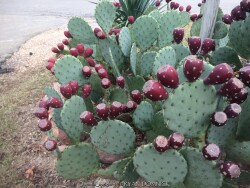

The yellow flowers, maroon long lasting fruits, and upright growth habit of this cactus (Opuntia engelmannii var. lindheimeri) create a unique addition to the desert garden. The pads are sparsely spined, light green, and hardy to about -5 degrees F. Native to arid soils in Texas and Oklahoma, this cactus has a place as one of the few upright cacti that can handle extreme cold. In fact, I have seen this species growing a in Lawrence, KS in desert gardens along a south wall of a house. With well drained soils and proper micro-climate, this cactus can handle our extreme cold and excess rainfall of Eastern Kansas.


***Description for this plant available with future update!***
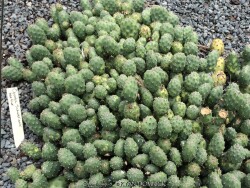

These tiny perennial succulent cacti (Opuntia fragilis 'Potato') produce globe-shaped, spherical stems make this selection unique. 'Potato' prickly pear is virtually spineless. It is native to mountainous areas in Western Colorado. The olive green "pads" take on a lovely winter blush of purple in cold weather. Grow this small native gem in a Kansas rock garden, in cracks between rocks, or on top of or in a retaining wall. You may also grow in flat areas like in between stepping stones provided you used a gravelly or sandy base for the stones. It will not tolerate rich moist soils as other plants or weeds will shade it out. Root rot can occur during lengthy hot humid summer rainy periods. If grown as a summer patio plant, move to a bright interior window over the winter before extreme cold occurs with no watering and keep above freezing. As a winter-only house plant, it will look presentable all winter long with just no waterings. Upon moving outside the following spring, plants with plenty of time to acclimate will thrive in full sun but be careful not to rush it or sunburning will occur. Generally if moving outside for the summer, allow 2-3 weeks of part shade or morning sun before placing in full sun. If grown in pots permanently outdoors, keep on the dry side in minerally sandy soil. You may leave out all winter allowing to freeze solid (Hardy to zone 4a); plants will go dormant and resume growth in the spring. As a permanent house plant, provide bright light and allow the soil to dry between waterings for many years of carefree enjoyment. Little potato-like pads are easy to propagate. Our original plant came from Plant Delights Nursery in North Carolina and also available on their mail-order website.
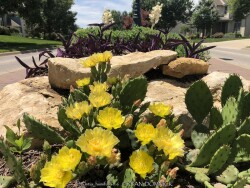

Eastern Prickly Pear Cacti (Opuntia humifusa) have attractive green pads, brilliant yellow flowers in June, and pinkish maroon edible fruits afterward that last into winter. They are native to eastern woods of Kansas, Missouri, Oklahoma, Texas, Arkansas and much of the Southeast United States. This cold hardy succulent occupies an unusual niche: growing in poor shallow sandstone based soils in open woods and on sunny rock cliffs that dry out too quickly for most other plants to colonize. Pads are sometimes carried off by animals and take root elsewhere. Grow this small native gem in rock gardens, dry shade areas, in parking lot medians, in cracks between rocks, or on top of or in a retaining wall. This species will grow in full sun or full shade! Although not picky about soils, just ensure that drainage is good. If grown in exterior pots and kept on the dry side, you may leave out all winter allowing to freeze solid; plants will go completely dormant and resume growth in the spring. Although these prickly pear do not have spines, they do have glochids. (painful bristles that come off and irritate the skin for a few days) Great low maintenance cold hardy and very versatile succulent.


Plains Prickly Pear Cacti (Opuntia macrorhiza) have attractive green pads, brilliant yellow flowers in June, and pinkish maroon edible fruits afterward that last into winter. They are native to much of the Great Plains from Texas to Minnesota. Pads are sometimes carried off by animals and take root elsewhere. Grow this small native gem in rock gardens, dry shade areas, in parking lot medians, in cracks between rocks, or on top of or in a retaining wall. Although not picky about soils, just ensure that drainage is good. If grown in exterior pots and kept on the dry side, you may leave out all winter allowing to freeze solid; plants will go completely dormant and resume growth in the spring. Although these prickly pear have spines and glochids. (painful bristles that come off and irritate the skin for a few days) so be careful around children and pets. Great low maintenance cold hardy and very versatile plant!


***Description for this plant available with future update!*** With extremely well drained soils and proper siting, this cactus seems to take our excess rainfall in Eastern Kansas. These and other hardy barrel cacti are perfect for a dry mounded xeriscape gardens under south facing roof overhangs where it gets no winter moisture. We are also testing this outside in our Lawrence, KS (zone 6a) crevice garden among other cold-hardy cacti, succulents, and yucca! Watch for future updates-Jan-2025


***Description for this plant available with future update!*** With extremely well drained soils and proper siting, this cactus seems to take our excess rainfall in Eastern Kansas. These and other hardy barrel cacti are perfect for a dry mounded xeriscape gardens under south facing roof overhangs where it gets no winter moisture. We are also testing this outside in our Lawrence, KS (zone 6a) crevice garden among other cold-hardy cacti, succulents, and yucca! Watch for future updates-Jan-2025


***Description for this plant available with future update!*** With extremely well drained soils and proper siting, this cactus seems to take our excess rainfall in Eastern Kansas. These and other hardy barrel cacti are perfect for a dry mounded xeriscape gardens under south facing roof overhangs where it gets no winter moisture. We are also testing this outside in our Lawrence, KS (zone 6a) crevice garden among other cold-hardy cacti, succulents, and yucca! Watch for future updates-Jan-2025


***Description for this plant available with future update!*** Cacti are known for their spines, unusual shapes and beautiful flowers. Both succulents and cacti store water in their fleshy tissues. And can survive long periods without water. Cacti and succulents are usually grown as a deck/patio plant or house plant in Kansas. Grow in full sun with little to no extra watering except that which comes from rainfall. Generally, plants may be brought out in Late May through Early October in our zone 6a Lawrence, KS climate. To play is safe, potted plants are best moved in before autumn leaves begin to drop and before night temperatures get below 45 degrees F. It is very important to avoid the combination of wet and cold. Move to a bright interior window over the winter with little to no watering and keep above 50 degrees F. As a winter house plant, it will look presentable all winter long with little to no waterings. As a permanent house plant, provide bright light and allow the soil to dry completely between waterings and you will get many years of carefree enjoyment. Plants grown permanently indoors may eventually begin to elongate stretching for light and lose their spine color. It can be hard to reproduce the intense UV sunlight they need when growing indoors so moving outside for the summer is best. Generally if moving outside for the summer, allow 1-2 weeks of part shade or morning sun before placing in full sun. Plants with time to acclimate will thrive in full sun but be careful not to rush it or sunburning may occur. Repotting may or may not be needed depending on how large you want the plant to grow; plants can continue to grow taller and tolerate extremely root-bound pots but may need wind bracing. If repotting, make sure to use a sharp draining low organic cactus mix with plenty of sand and perlite but avoid peat moss. The “soil” most commercial cacti are potted in to too peaty and light weight. This soil becomes hydrophobic and shrinks after becoming bone dry and difficult to re wet again. Cacti never grow in peat-based soils in nature; this “Soil” is only good for shipping because of the light weight. Potted plants are very low maintenance but watch for scale and mealybugs that may hide beneath the cover of spines. The best pest removal approach is to periodically wash the cactus off. Achieve this with a water nozzle or hose breaker turned mostly off to increase the pressure from the blast of water. This high-pressured water kills the pests without damaging the thick cactus skin. Here are some little-known or rare factoids about cacti: 1. The "spines" are actually modified leaves filled with sap at first, then quickly drying out to form the spines! 2. Many cacti have bright colored flowers that mainly attract bees, while some tubular flowering types attract hummingbirds and bats. 3. Late on the evolutionary timeline, cacti fossils are rare to non-existent. Cacti are native almost exclusively to the Americas, while succulents can include a much larger plant palette be from any dry area in the world. 4. Some cactus plants have been known to survive more than 2 years without water. 5. Some cacti first evolved in a dry climate that later became wetter again. For example: several jungle species live as epiphytes in trees to achieve the fast drainage they need.